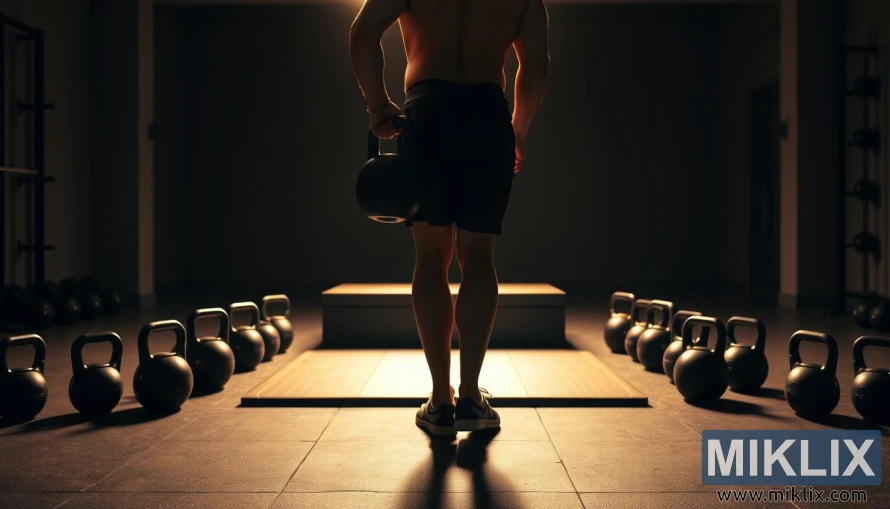Image: Posterior Chain Kettlebell Training
Published: April 3, 2025 at 4:35:33 PM UTC
Last updated: September 24, 2025 at 3:44:18 PM UTC
Dimly lit gym scene with a person performing a kettlebell hip hinge, surrounded by weights, highlighting strength, discipline, and focused training.
The dim glow of warm overhead lighting spills across the gym floor, casting long shadows that give the space a cinematic weight, as if every detail here carries meaning. The figure at the center stands tall yet grounded, his posture a blend of readiness and discipline. Bare-backed, his shoulders ripple subtly under the subdued light, muscles outlined not in ostentation but in function, the result of countless repetitions and steady commitment. His stance is firm, legs slightly bent and aligned with purpose, the straight line of his back signaling not just correct form but also the respect he holds for the craft of lifting. In one hand, he grips a heavy kettlebell, its iron surface catching the glow, reflecting both the effort it demands and the promise it carries.
Around him, kettlebells of varying sizes form a silent circle, like sentinels waiting their turn to be called into action. Each one, though still and unassuming, represents hours of challenge, perseverance, and growth. Their deliberate arrangement across the black-matted floor speaks to both order and progression, tools of discipline lined up in readiness. The sturdy weightlifting platform positioned just ahead of the figure completes the composition, its raised surface symbolizing a stage of performance, a place where strength is tested and mastery revealed. The grain of its textured surface suggests durability, a foundation that will bear the weight of effort again and again, indifferent yet essential to the athlete’s pursuit.
The gym itself is minimalist, designed with clarity in mind. There are no distractions, no unnecessary frills—only what is needed to push the body and mind further. The absence of clutter mirrors the internal state required for such training: focus sharpened, intention unwavering, all energy directed toward the next lift. The shadows in the far corners of the space suggest quiet solitude, a haven for the individual’s battle with resistance, where each swing, hinge, and lift is not just an exercise but a dialogue between body and weight, discipline and challenge. In this subdued environment, the hum of silence is broken only by the rhythmic sound of exertion, the muffled impact of iron on floor, and the steady breaths of determination.
The figure’s position in the scene, standing poised with a kettlebell in hand, carries symbolic weight beyond its immediate physicality. He is caught in a moment suspended between preparation and execution, embodying the essence of posterior chain training: rooted in form, reliant on balance, and fueled by power generated through the core and legs. The exercise he is about to perform is more than mechanical repetition; it is a ritual of discipline, a cultivation of strength that extends beyond the gym walls. Every hinge of the hips, every tightening of the grip, and every controlled motion reinforces resilience, not just in muscles but in mindset.
What unfolds in this space is not simply exercise but transformation. The gym becomes a sanctuary of self-discipline, where the weights serve as mirrors reflecting the individual’s endurance, patience, and inner drive. The warm lighting does not merely illuminate the contours of the body—it underscores the humanity of the struggle, the vulnerability of facing a challenge, and the triumph of choosing to engage with it. In this balance between light and shadow, weight and lift, stillness and movement, the image encapsulates the profound simplicity and power of training: an act of resistance not just against gravity, but against limitation itself.
The image is related to: Kettlebell Training Benefits: Burn Fat, Build Strength, and Boost Heart Health

